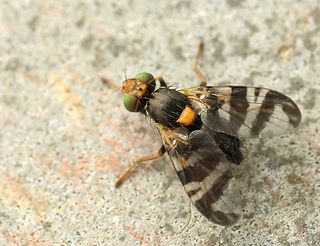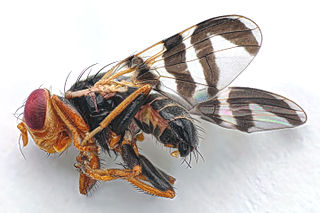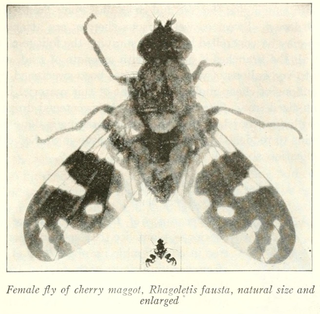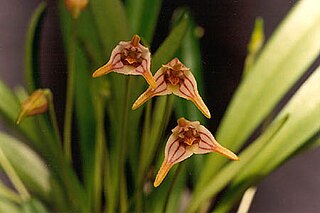
The apple maggot, also known as the railroad worm, is a species of fruit fly, and a pest of several types of fruits, especially apples. This species evolved about 150 years ago through a sympatric shift from the native host hawthorn to the domesticated apple species Malus domestica in the northeastern United States. This fly is believed to have been accidentally spread to the western United States from the endemic eastern United States region through contaminated apples at multiple points throughout the 20th century. The apple maggot uses Batesian mimicry as a method of defense, with coloration resembling that of the forelegs and pedipalps of a jumping spider.

Rhagoletis is a genus of tephritid fruit flies with about 70 species.

Fragilariophyceae is a group of pennate diatoms lacking a raphe.

Rhagoletis cerasi is a species of fruit fly in the family Tephritidae.
Rhagoletis acuticornis is a species of tephritid or fruit flies in the genus Rhagoletis of the family Tephritidae.

Rhagoletis batava is a species of tephritid or fruit flies in the genus Rhagoletis of the family Tephritidae. Rhagoletis batava larvae feed inside fruit flesh, and can be important pest of seabuckthorn. This species is very similar to Rhagoletis cerasi
Rhagoletis berberis is a species of tephritid or fruit flies in the genus Rhagoletis of the family Tephritidae.

Rhagoletis fausta, the black-bodied cherry fruit fly, is a species of tephritid or fruit flies in the genus Rhagoletis of the family Tephritidae. It is found in the United States and Canada.
Rhagoletis juglandis, also known as the walnut husk fly, is a species of tephritid or fruit fly in the family Tephritidae. It is closely related to the walnut husk maggot Rhagoletis suavis. This species of fly belongs to the R. suavis group, which has a natural history consistent with allopatric speciation. The flies belonging to this group are morphologically distinguishable.
Rhagoletis juniperina is a species of tephritid or fruit flies in the genus Rhagoletis of the family Tephritidae.
Rhagoletis ramosae is a species of tephritid or fruit flies in the genus Rhagoletis of the family Tephritidae.

Rhagoletis suavis, also known as the walnut husk maggot, is a species of tephritid or fruit fly in the family Tephritidae. This fly is closely related to, but not to be confused with, Rhagoletis juglandis, or the walnut husk fly. It occurs in North America.
Rhagoletis willinki is a species of tephritid or fruit fly in the genus Rhagoletis of the family Tephritidae.

Rhagoletis zephyria is a species of tephritid or fruit fly in the genus Rhagoletis of the family Tephritidae.
Rhagoletis cingulata, the eastern cherry fruit fly, is a species of tephritid or fruit flies in the genus Rhagoletis of the family Tephritidae. The cherry fruit fly, Rhagoletis cingulata (Loew), is found from Michigan to New Hampshire, southward to Florida, occurring over the entire middle and eastern region of the United States and also in southeastern and southcentral Canada.

Masdevallia striatella is a species of orchid that occurs from Costa Rica to western Panama.

Chromodoris striatella is a species of colourful sea slug, a dorid nudibranch, a marine gastropod mollusc in the family Chromodorididae.

Isophrictis striatella is a moth of the family Gelechiidae. It is found in most of Europe, as well as Turkey and North America.

Symmetrischema striatella is a moth in the family Gelechiidae. It was described by Mary Murtfeldt in 1900. It is found in North America, where it has been recorded Alabama, Arkansas, California, Florida, Illinois, Louisiana, Maine, Maryland, Mississippi, Missouri, New Jersey, Oklahoma, South Carolina, Tennessee and Texas. This species has also been accidentally introduced to New Zealand.










